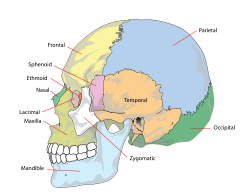Temple (anatomy)
| Temple (anatomy) | |
|---|---|

Location of temple
|
|

Human skull. Temporal bone is orange, and the temple overlies the temporal bone as well as overlying the sphenoid bone.
|
|
| Details | |
| Artery | superficial temporal artery |
| Vein | superficial temporal vein |
| Identifiers | |
| Latin | Tempus |
| Dorlands /Elsevier |
t_04/12793657 |
| TA | A01.1.00.004 |
| FMA | 46450 |
|
Anatomical terminology
[]
|
|
Temple indicates the side of the head behind the eyes. The bone beneath is the temporal bone as well as part of the sphenoid bone.
Cladists classify land vertebrates based on the presence of an upper hole, a lower hole, both, or neither in the cover of dermal bone that formerly covered the temporalis muscle, whose origin is the temple and whose insertion is the jaw. The brain has a lobe called the temporal lobe.
The word "temple" as used in anatomy has a separate etymology from the word temple, meaning "place of worship". Both come from Latin, but the word for the place of worship comes from templum, whereas the word for the part of the head comes from Vulgar Latin *tempula, modified from tempora, plural form ("both temples") of tempus, a word that meant both "time" and the part of the head. Due to the common source with the word for time, the adjective for both is "temporal" (both "pertaining to time" and "pertaining to the anatomical temple").
Regarding the temporalis muscle: in English, this muscle’s name is the time muscle. The word temporalis comes from the Latin word tempus meaning “time.” The muscle covers the temporal bone, or time bone, which received its name because the hair of the head covering this bone is often the first hair to turn gray during the aging process. Therefore, this region is the first to show the effects of aging.
...
Wikipedia
